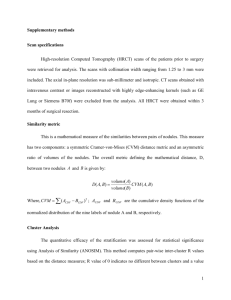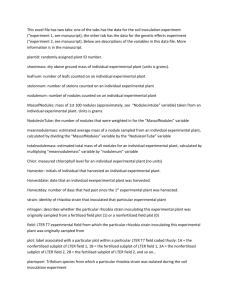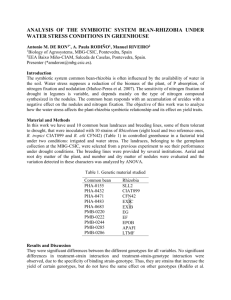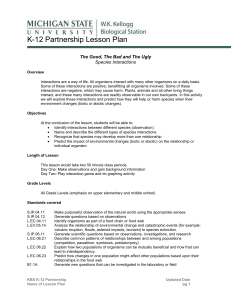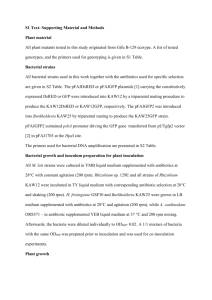Collecting Nodules-Isolating Rhizobium
advertisement
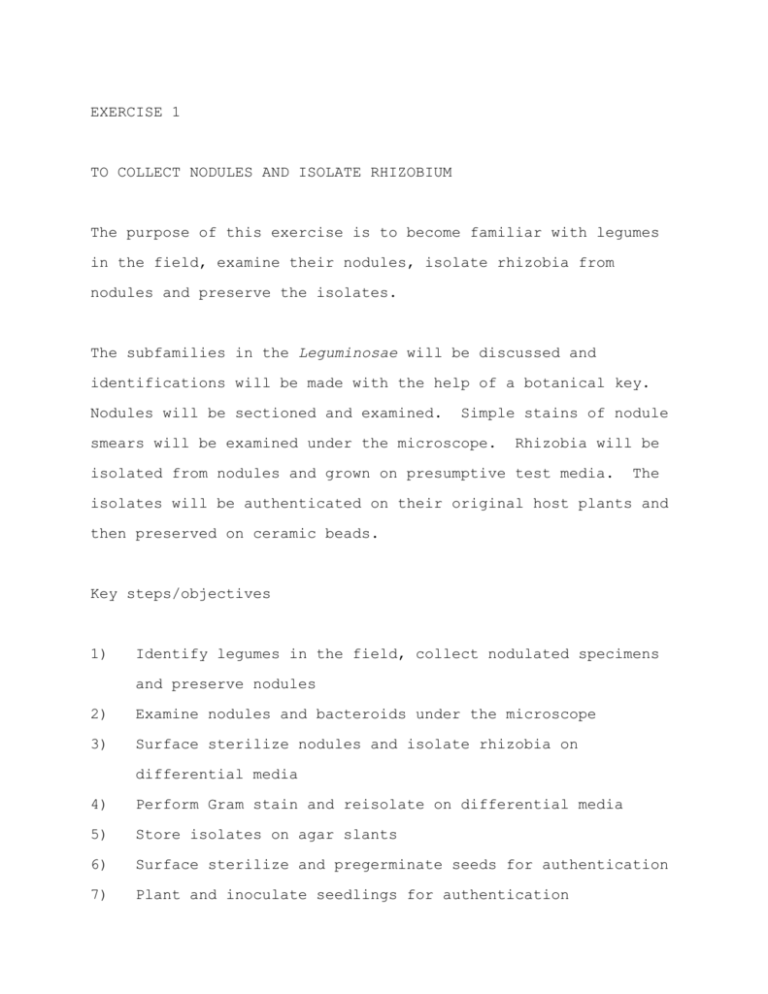
EXERCISE 1 TO COLLECT NODULES AND ISOLATE RHIZOBIUM The purpose of this exercise is to become familiar with legumes in the field, examine their nodules, isolate rhizobia from nodules and preserve the isolates. The subfamilies in the Leguminosae will be discussed and identifications will be made with the help of a botanical key. Nodules will be sectioned and examined. Simple stains of nodule smears will be examined under the microscope. Rhizobia will be isolated from nodules and grown on presumptive test media. The isolates will be authenticated on their original host plants and then preserved on ceramic beads. Key steps/objectives 1) Identify legumes in the field, collect nodulated specimens and preserve nodules 2) Examine nodules and bacteroids under the microscope 3) Surface sterilize nodules and isolate rhizobia on differential media 4) Perform Gram stain and reisolate on differential media 5) Store isolates on agar slants 6) Surface sterilize and pregerminate seeds for authentication 7) Plant and inoculate seedlings for authentication 8) Examine plants periodically for nodulation 9) Terminate experiment, examine nodules and reisolate 10) Prepare broth culture of authenticated isolate for desiccation on beads 11) Prepare bead storage vials 12) Impregnate sterilized beads with broth culture of rhizobia 13) Regrow rhizobia stored on beads (a) Recognizing legumes and identifying them in the field (Key step 1) Become familiar with the general taxonomic characters of the Leguminosae. Study the different flower types of the three subfamilies: Caesalpinoideae, Mimosoideae and Papilionoideae (Appendix 1). Note the main similarities among all legumes in their compound leaves and the seed placentation in pods as shown in Appendix 1, Figure A.4 and A.5. However, in many Acacia species (e.g., Acacia auriculaeformis, Acacia mangium, Acacia koa) the compound leaves are only formed and seen in seedlings. The compound leaves are replaced by phyllodes as the plants mature (Figure A.5). Compound leaves are also characteristic of numerous non-leguminous families such as: Bignoniaceae (e.g., Jacaranda, Spathodea); Caprifoliaceae (e.g., Sambucas mexicana var. bipinnata); Solanaceae (e.g., Lycopersicon, Solanum tuberosum), Passifloraceae (e.g. Passiflora spp.). Familiarize yourself with the basic characteristics of each subfamily as outlined in Appendix 1. Learn to identify legumes in the field and become familiar with the appearance of the most common agricultural legumes in your area. It is not essential to identify the less common legumes. Many aspects of classification within the Leguminosae are in dispute even amongst plant taxonomists. The course followed by many collectors is to recover a good plant specimen (including flowers and fruits), dry and press it, and forward it to a reliable herbarium (Royal Botanical Garden, Kew, Richmond, Surrey TW 3 AE, England) for precise identification. (b) Recovering nodules in the field (Key Step 1) Identify plants of several legume species in the field and select one representative of each for sampling. With a spade, describe a circle with a radius of approximately 15 cm around the plant and cut out this section to a depth of at least 20 cm. using the spade, slowly lift out the clump. soil from the root material with your hands. Still Carefully remove the Avoid detaching secondary roots from the plant as nodules may be found on the lateral roots as well as the tap root. plant into a plastic bag. Carefully place the whole If the legume has seed, collect the seeds and store them in the refrigerator for the authentication test. In the laboratory, place a sieve of an appropriate size and mesh under each root sample to catch nodules that may become detached from the root. Carefully wash the roots under a gentle stream of water from a tap or a hose. The distribution of the nodules on the root system is dependent on the legume species and rhizobial strain as well as soil structure and composition. Examples of nodule types and distribution on some species are illustrated in Appendix 1. (c) Preserving nodules (Key step 1) Fresh nodules may be stored in the refrigerator overnight. Do not freeze nodules as ice crystals may rupture and kill the bacteroids. Frozen nodules may, however, be used for serological typing. For long term storage, desiccation in glass vials is recommended. A preservation vial is shown in Appendix 2, Figure A.8. (d) Examining nodules and bacteroids (Key step 2) Note the shape and size of the nodules recovered from the collected plants. Nodule size and shape vary with the rhizobia and host plant species. Large round nodules may be found on cowpea and soybean plants. Leucaena and Acacia are among legumes which do not have round nodules. See Appendix 1, Figure A.6 for description of nodule shape. Cut thin sections of nodules with a razor blade and float them on a drop of water on a microscope slide; use a cover glass and examine under low power (10x) and high power (40x) objectives. An active N-fixing nodule contains a protein called leghaemoglobin. Its presence in the nodule can be noted by the characteristic pink, red, or brown coloration. may also be black. Active nodules Black nodules are not very common. They have been reported on Lablab purpureus, Dolichos biflorus, and Vigna unguiculata when inoculated with some strains of rhizobia. Senescent nodules are usually grayish green. When nodules on the soil surface are exposed to sunlight, they may develop a green exterior. This green color is due to chlorophyll development on the cortical region of the nodule. Most ineffective rhizobia cause nodules with white interiors that lack leghaemoglobin. Gently rub the cut surface of a nodule on a clean microscope slide to make a smear. Allow the smear to air dry and then pass the slide through a flame. Cool the slide and stain the smear with dilute carbol fuchsin for 10-20 seconds. blot off excess moisture, and air dry. immersion objective. Wash in water, Examine under the oil Note the difference in morphology between the "bacteroids" in this smear and bacteria of the same rhizobial species grown in pure culture. Note the size and shape of the bacteroids compared to the rod forms found in pure culture (Figure 3.1). (e) Isolating rhizobia from a nodule (Key step 3) Wash roots thoroughly to remove soil. from each plant. Collect about 10 nodules Sever the nodule from the root by cutting the root about 0.5 cm on each side of the nodule. When moving the nodule, use forceps on the root appendages to reduce the risk of damaging the nodule. Immerse intact, undamaged nodules for 5-10 seconds in 95% ethanol or isopropanol (to break the surface tension and to remove air bubbles from the tissue); transfer to a 2.5-3% (v/v) solution of sodium hypochlorite, and soak for 2-4 min. Rinse in five changes of sterile water using sterile forceps for transferring. Forceps may be sterilized quickly by dipping in alcohol and flaming. Utilize sterile glass or plastic petri dishes as containers for the alcohol, sodium hypochlorite and water. Alternatively, nodules may be placed into an Erlenmeyer flask (125 ml). The sterilizing and rinsing fluids may be changed as required, leaving the nodule in the flask each time. An acidified mercuric chloride solution (0.1% w/v) or a solution of hydrogen peroxide (3% v/v) may be used for sterilizing nodules. However, mercuric chloride is highly toxic and hydrogen peroxide is expensive, making sodium hypochlorite (available as commercial bleach) the preferred choice. When hydrogen peroxide is used, the 5-6 rinses with sterile water may be omitted. Desiccated nodules must be rehydrated before sterilizing. Place nodules into a small beaker with clean cool water and leave in the refrigerator to imbibe overnight. An one hour soaking at room temperature is sufficient for nodules which have been desiccated for only a short time. Crush the surface sterilized nodule with a pair of blunt-tipped forceps in a large drop of sterile water in a petri dish. Alternatively, the nodule may be crushed in a sterile test tube with a sterile glass rod. Streak one loopful of the nodule suspension on a yeast-mannitol agar (YMA) plate containing Congo Red (CR). Similarly treat one loopful of the nodule suspension on a yeast-mannitol agar (YMA) plate containing bromthymol blue (BTB) (Appendix 3). The primary isolate may be streaked in one continuous motion as shown in method 1 of Figure 1.1. Well isolated colonies may be obtained with method 2 which is most commonly used with isolations from primary plates. It is performed as follows: Deposit culture on agar with inoculation loop then streak out to 1. Resterilize loop, and cool by touching the agar surface near the side of the Petri dish, then streak from 1 to 2. Repeat the procedure until 4 is reached. The isolation procedure lends itself well to improvisation and many variations exist. Here are some variations ─ try them and compare your success at isolation by at least two methods. The needle method of isolation is especially useful with freshly harvested nodules 2 mm or larger in diameter. Wash the nodule first in water, then alcohol, then hold it with forceps and briefly pass it through a flame. Place this surface sterilized nodule on a small piece of sterile filter paper (2 cm x 2 cm) in a sterile Petri dish. for each nodule. nodules. A new piece of filter paper should be used The same Petri dish can be used for several Dip the blunt tipped forceps into 95% alcohol and flame momentarily. While holding the nodule with the forceps and Figure 1.1 Streaking the plate. resting the nodule on sterile filter paper, quickly slice off a small section with a flamed, hot scalpel. Still holding the nodule with the forceps on the filter paper, insert the tip of a sterile inoculation needle (with a 1 mm loop) into the cut surface. Load the loop with inoculum. Streak directly onto a YMA plate containing CR and a YMA plate containing BTB. When using the needle method, the nodule can also be held in the fingers of one hand while inserting the needle with the other hand. Brace the heels of the hands together to steady them. Another method consists of serially diluting the nodule bacterial suspension and then pour-plating it. This is done as follows: lay out four sterile plastic Petri dishes marked A, B, C, and D. With a sterile Pasteur pipette, place two separated drops of water into each dish. Crush the sterilized nodule in a sterile Petri dish or test tube. Flame the transfer loop and cool it in drop-1 of dish-A, then transfer the bacteroid suspension from the crushed nodule to drop-2 of dish-A and mix. Next, flame the loop, cool it in drop-1 of dish-B, and transfer one loopful from drop-2 of dish-A to drop-2 of dish-B and mix. Continue until drop-2 of each dish has been inoculated and mixed with the diluted nodule suspension of the previous one. Pour 15-20 ml liquid YMA (48C) to the inoculum in each dish. Ensure mixing by gently moving the covered dish first clockwise and then counter-clockwise on the table top. circles for each movement. Allow three full Continue mixing by moving the dish from the left to the right and from the right to the left three times. Then, without pausing, move the Petri-dish forward and backward and backward and forward, also three times. agar to set before incubating. Allow the Invert the plates during incubation. Additional procedures are illustrated in Figure l.2. Figure 1.2. Isolation procedures as used by Date and Halliday (1979b) (f) Performing the presumptive test (Key steps 4 and 5) The plates prepared from the three methods described above are referred to as primary isolation plates. 25-30C in the dark. Incubate these at (Some slow-growing tropical rhizobia absorb Congo Red when incubated in light.) After 4-10 days, look for well isolated colonies. Pick off a single colony typical of rhizobia (Exercise 3) and perform a Gram stain (Exercise 3), then reisolate by streaking on: a) YMA containing BTB b) YMA containing CR c) Peptone glucose agar Select isolated typical colonies. It is possible that more than one type colony (e.g. small and large colonies; mucoid and dry, etc.) may appear on a plate streaked from a single nodule. Each of these should be streaked on the three media listed above and considered an individual culture. More than one type of colony in a pure culture of rhizobia may be indicative of variants of the same strain or the occupancy of two different strains in the same nodule. If no isolated colonies develop, restreak a little of the confluent growth again onto each one of the three media. Incubate and make daily observations for the appearance of colonies typical of rhizobia. Colonies should show little or no Congo Red absorption when incubated in the dark. There are, however, exceptions (eg. some strains of R. meliloti absorb Congo red strongly). A blue color indicative of an alkaline reaction on BTB should be obtained with slow-growing Bradyrhizobium spp. A yellow color (acid) reaction is usually produced by the fast-growing Rhizobium spp. No growth or poor growth should be obtained on peptone glucose agar. Plates should be read for reactions after 3-5 days (fast-growers) and 5-7 (slow-growers). (Unless one is definitely working with fast-growers, an incubation of 7-10 days should be routine.) details. Check Exercise 3 for Check secondary isolates for colony morphology typical of rhizobia, then perform a Gram stain (Exercise 3) to check for purity of culture. Transfer three separate colonies to culture tubes to be added to stock cultures. Stock cultures obtained at this time are considered presumptive rhizobia. The authenticity of these isolates as pure cultures of rhizobia is confirmed later by the nodulation test (authentication) under bacteriologically controlled conditions. Select two representative colonies of the presumptive rhizobia from the isolation. Prepare 20-50 ml broth cultures in duplicates from each of the two colonies. Incubate on a shaker for use in the authentication tests. (g) Authenticating the isolates as rhizobia (Key steps 6, 7, 8, and 9) The importance of determining that the isolate is a pure culture which can form nodules on legume roots cannot be over stressed. It proves the authenticity of a pure culture of rhizobia. For large seeded legumes like beans (Phaseolus vulgaris) and soybean (Glycine max), Leonard jars and growth-pouches are recommended as growth units for authentication. Smaller seeded legumes, like clovers (Trifolium spp.) and Siratro (Macroptilium atropurpureum), may be grown in growth-tubes. Recommended hosts and growth systems to authenticate isolates are given in Appendix 9. Ideally, a rhizobial strain is tested for its ability to produce nodules on the legume species from which it was originally isolated. However, it may be more convenient to substitute another legume from the same cross-inoculation group particularly when a small-seeded legume can be substituted for a large-seeded one. Chickpea, although a large seeded legume, can be successfully grown in tubes by excising the cotyledons. process produces dwarfed chickpea plants. This Siratro is used in authenticating most bradyrhizobia from tropical legumes because it nodulates with more than 90% of all bradyrhizobia. Rhizobia from specific hosts (e.g.. soybean, Lotononis, chickpea, etc.) are not authenticated on Siratro. Set up two suitable growth units for each of the isolates plus at least two extra units that will serve as uninoculated controls. Consult Appendix 11 for the preparation of Leonard jars. Growth pouches are described in Exercise 5 and Appendix 8. Surface sterilize and pregerminate seeds as detailed in Appendix 10. Inoculate 1 ml of broth culture for each isolate onto each of the pregerminated seeds in two growth units. The extra growth units are not inoculated and will serve as controls. Plant and inoculate in a clean area. Take precautions against wind drafts and insects which may cause cross-contamination between treatments. Examine plants for differences in vigor and color between the inoculated and uninoculated at 15-30 days of growth. Remove the plants from the rooting medium and note the presence or absence of nodules. The presence of nodules in the non-inoculated treatment invalidates the test. Sparse nodulation or nodulation restricted to distal parts of the roots of control plants indicates external contamination and points to a need to improve general hygiene. The authentication test must be repeated with adequate bacteriological control. If the presumptive tests are satisfactory, the isolates are regarded as fully authenticated cultures. The cultures of presumptive isolates are now confirmed as rhizobia and may be given collection numbers. When added to a culture collection, other relevant information should be added for each strain e.g. parent host, site of collection, soil pH, etc. (h) Preserving culture of rhizobia (Key steps 10, 11, 12, and 13) There are a number of satisfactory methods for preserving rhizobial cultures including yeast mannitol agar (YMA) slant in screw-cap tubes, desiccated on porcelain beads, lyophilized (freeze-dried), and as frozen liquid suspension under liquid nitrogen. The choice of method will depend on facilities, experience, and finances (Table 1.1). The porcelain bead method is recommended for laboratories with limited resources. To prepare for storage on beads, inoculate a loopful of culture from a YMA slant into 3 ml of sterile YM-broth and incubate to maximum turbidity on a rotary shaker. Place 20-30 ceramic beads (washed and oven dried) in a screw-cap test tube, cover the mouth of the tube with foil, and sterilize in the oven for 1-2 h at 160-170C. Prepare storage tubes as depicted in Figure 1.4, using 6-7 g silica gel and sufficient cotton or glass-wool to keep the silica gel in place. The rubber lined caps for the tubes must be autoclaved separately in a rubber beaker, then dried in an oven at 80-90C. The glass-wool may be oven sterilized in the storage tube with the silica gel. When cotton is used, it should be autoclaved in small balls in a foil covered beaker. These cotton balls should be of a suitable size to facilitate easy aseptic transfer to the storage tube with forceps. Residual moisture is removed in the oven at 70-80C before transferring it aseptically to the sterile storage tubes. The autoclaved caps are then added to the tubes. Transfer the sterilized beads aseptically to the broth culture in the tubes and replug. Soak the beads for 1-2 h, then invert the tube and allow the excess broth culture to soak into the cotton plug. Transfer the beads impregnated with rhizobia into the storage tube aseptically, replace and tighten the screw caps securely. Examine the tubes after a day or so to ensure that the silica gel is still blue. If it turns pink or colorless, then too much moisture was transferred with the beads or an improper seal is permitting entry of moisture. To regenerate a culture, inoculate YM-broth with one or two beads. These are easily speared from the storage tube using a sterile needle with a slight hook. to obtain visual signs of growth. A week or more may be needed Once the broth becomes turbid, loopfuls should be streaked on presumptive test media to check for purity. desired. Subculture from the broth onto YMA slants as Figure 1.3. Ceramic bead method for storing Rhizobium Method Expertise and facilities required Length of useful storage period Advantages Disadvantages Remarks Agar slopes in screw cap tubes or agar covered with paraffin oil (Vincent 1970 p. 10) Basic microbiological knowledge and facilities for pure culture (autoclave, clean transfer area, tubes, media, etc.) 1-2 years without transfer at 25-30 but can be longer, if held at 5C Simplicity, low cost minimum facilities and expertise Short storage time, increased chance of contamination and variants because of more frequent subculturing Least desirable for long term storage Porcelain beads As above, plus availability of beads, suitable airtight containers and dry sterilizing facilities for silica gel desiccant 3-4 years, with some rhizobia significantly shorter with others Low cost and longer storage time and therefore more time before re-beading. Facility for number of sub cultures (i.e., one bead) from original Not as long term as lyophilization and risk of contamination and variants when re-beading. Time required for re-beading Good for 6-12 month storage* Lyophilized or freeze dried Basic microbiological facilities lyophilizing equipment (vacuum pump, freezing facility under vacuum) ampoules, glass blowing burner, etc. Minimum 15-20 years experience suggests much longer Once ampouled, minimal risk of variants or contamination. virtually permanent storage. Can be at room temperature Expensive for equipment and materials Preferred Liquid N storage Expertise as above, plus cryostat and liquid N source Years, but not much information available Rapid operation Very expensive; special precautions during freezing and thawing None Table 1.1 Methods for preservation of strains of Rhizobium *Poor survival with some fast-growing rhizobia (e.g. R. phaseoli and Leucaena and Sesbania rhizobia) fused CaCl2 can be used as a substitute for silica gel Requirements (a) Recognizing legumes and identifying them in the field. A suitable botanical key describing the identification of legumes. (b) Recovering nodules in the field. Refrigerator Spade Sieve Running water Plastic bags for plants, smaller bags for seeds (c) Preserving nodules Refrigerator Collection vial (Appendix 2) Nodules from (b) (d) Examining nodules and bacteroids Microscope Bunsen burner Microscope slides, cover slips, mounting fluid Razor blade, inoculation loop Distilled water Carbol fuchsin stain (Appendix 3) Rhizobial cultures Nodulated plants from (b) (e) Isolating rhizobia from a nodule Refrigerator Scissors, forceps, inoculation loop, isolation needle Scalpel Sterile Petri dishes Sterile test tubes, glass rods Erlenmeyer flask 125 ml (optional), small beaker Bunsen burner Sterile Pasteur pipettes Sterile filter paper (cut into small pieces) Running water, sterile water, ethanol or isopropanol Sodium hypochlorite solution, 3% (may be made from commercial bleach) Plates of plain YMA, plates of YMA + Congo Red and YMA + BTB Liquid YMA (50C) Nodulated plants from (b) Desiccated nodules f) Performing the presumptive test Transfer chamber Incubator Bunsen burner Inoculation loop YMA slants Flasks (125 ml) with 50 ml YM broth Plates of YMA + BTB, YMA + Congo red, and YMA and peptone glucose agar Gram stain solutions (g) Authenticating the isolates as rhizobia Transfer Chamber Greenhouse, growth-room or shelf Drying oven Kjeldahl N determination equipment (optional) Racks for growth pouches and growth tubes 10 ml pipettes (sterile) Alcohol burners Scissors, paper bags for plant tops Growth pouches, growth tubes (Exercise 5, Appendix 8) Leonard jars (Appendix 11) Materials and glassware for seed sterilization (Appendix 10) Broth cultures from (f) (h) Preserving rhizobial cultures Transfer chamber Rotary shaker Sterilizing oven, drying oven Forceps, inoculation loop, flame, hooked needle Test tube racks, screw capped test tubes Ceramic beads (washed and dried) Silica gel (with indicator), absorbent cotton, aluminum foil Beaker (400 ml) Capped tubes with 3 ml YM broth, culture tubes with YMA slants Cultures of rhizobia
